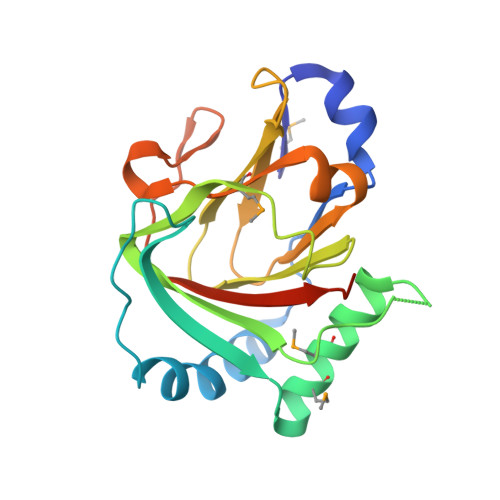The atomic resolution structure of human AlkB homolog 7 (ALKBH7), a key protein for programmed necrosis and fat metabolism
Wang, G., He, Q., Feng, C., Liu, Y., Deng, Z., Qi, X., Wu, W., Mei, P., Chen, Z.(2014) J Biological Chem 289: 27924-27936
- PubMed: 25122757
- DOI: https://doi.org/10.1074/jbc.M114.590505
- Primary Citation of Related Structures:
4QKB, 4QKD, 4QKF - PubMed Abstract:
ALKBH7 is the mitochondrial AlkB family member that is required for alkylation- and oxidation-induced programmed necrosis. In contrast to the protective role of other AlkB family members after suffering alkylation-induced DNA damage, ALKBH7 triggers the collapse of mitochondrial membrane potential and promotes cell death. Moreover, genetic ablation of mouse Alkbh7 dramatically increases body weight and fat mass. Here, we present crystal structures of human ALKBH7 in complex with Mn(II) and ¦Á-ketoglutarate at 1.35 ? or N-oxalylglycine at 2.0 ? resolution. ALKBH7 possesses the conserved double-stranded ¦Â-helix fold that coordinates a catalytically active iron by a conserved HX(D/E) ¡ Xn ¡ H motif. Self-hydroxylation of Leu-110 was observed, indicating that ALKBH7 has the potential to catalyze hydroxylation of its substrate. Unlike other AlkB family members whose substrates are DNA or RNA, ALKBH7 is devoid of the "nucleotide recognition lid" which is essential for binding nucleobases, and thus exhibits a solvent-exposed active site; two loops between ¦Â-strands ¦Â6 and ¦Â7 and between ¦Â9 and ¦Â10 create a special outer wall of the minor ¦Â-sheet of the double-stranded ¦Â-helix and form a negatively charged groove. These distinct features suggest that ALKBH7 may act on protein substrate rather than nucleic acids. Taken together, our findings provide a structural basis for understanding the distinct function of ALKBH7 in the AlkB family and offer a foundation for drug design in treating cell death-related diseases and metabolic diseases.
Organizational Affiliation:
From the State Key Laboratory of Agrobiotechnology, China Agricultural University, Beijing 100193 and.



















